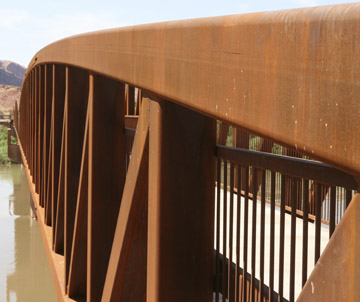Weathering Steel: Taking the Guesswork Out of Filler Metal Selection
Due to the addition of copper, nickel and chromium, weathering steel offers excellent resistance to atmospheric corrosion caused by rain, snow or humidity. It also provides a unique aesthetic appeal and is easily identified by its typically reddish, rust or patina, which also protects the material from the elements and makes it desirable for both structural and artistic applications. During the welding process, the filler metal type and the manner in which it is applied determines whether the resulting weld will match corrosion resistance or have the same reddish appearance, more commonly known as color match.

chromium that help improve the corrosion resistance of the
steel to atmospheric sources.
Weathering steel specifications include ASTM A242, A588, A606, A847 ASTM A709 and AASHTO M270, along with patented formulations like U.S. Steel’s COR-TEN®.
The basics of filler metal selection
The code and specification requirements for the job, as well as the necessary strength and toughness levels dictate which filler metal to choose for a weathering steel application. The location of the weld, whether it will be painted, and the joint geometry and weld size also factor into the selection. Additionally, whether the weld needs to match the color of the steel should be considered.
The American Welding Society (AWS) steel welding codes, D1.1 and D1.5, which respectively govern structural and bridge welding, specifically address the use of weathering steels, including welding methods that are appropriate for the different service environments for these materials. Strength levels for weathering steel can reach 100 ksi yield, but the most common levels are around 50 ksi yield and 70 ksi tensile. Toughness requirements can also vary depending on the grade of steel. Typically, the chosen filler metal needs to meet the minimum mechanical properties of the base material. It’s important to confirm the exact specification and grade of weathering steel, as well as the design requirements when making a filler metal selection. In some cases, over- or under-matching of the strengths is allowable.
When selecting a filler metal for this material, consider two key factors: 1) What corrosion characteristics does the weld need to provide? 2) Is it necessary for the weld to match the color of the base material? Welds that are going to be painted over or that are less exposed to the elements may not require a corrosion resistant or color matching filler metal.
If matching atmospheric corrosion resistance is necessary, carbon steel or low alloy filler metals may be used depending on the application. Common filler metals include:
- Carbon steel filler metals, AWS E7018, ER70S-3 or -6 E70C-6M, E71T-1, etc.
- Low-alloy filler metals with B2, K2, CX, NiX, or WX chemistries, such as AWS E8018-C3, ER80S-Ni1, E80C-Ni1, E81T1-W2, etc
Carbon Steel Filler Metals.
Carbon steel filler metals may be used if the weathering steel has a minimum yield strength requirement of 50 ksi and groove welds are single-pass or one pass on each side of the weldment. For fillet welds, this type of filler metal can be used if the weld’s leg sizes will be less than or equal to 5/16 inch when using solid wire, metal-cored wire or flux cored wires, or 1/4 inch when using stick electrodes. Carbon steel filler metals are a cost-effective option due to fewer alloying elements being incorporated into their formulations. Instead, these deposits are alloyed in the final weld through the high amount of base metal dilution that occurs when placing smaller, single-pass welds on weathering steels. This dilution helps ensure the weld features the same atmospheric corrosion resistant properties as the weathering steel.
Low alloy filler metals
Larger, multi-pass welds generally do not experience the same amount of base material dilution when welded and therefore require low alloy filler metals that can provide proper corrosion resistance. Also carbon steel filler metals may not be able to match mechanical properties of weathering steel grades with higher strength and toughness. The most commonly used low alloy filler metals are those with a nickel content of 1 percent (indicated by Ni1 for wire or C3 for stick electrodes) or products with “W” (weathering) chemistry designations. Low alloy filler metals for weathering steel generally have 80ksi minimum tensile strength and 60 ksi minimum yield strength, which provides an overmatch of strength to the majority of grades, which are approximately 70ksi minimum tensile and 50 ksi minimum yield strength. While overmatching filler metal to base metal strength is not always allowed in welding applications, it is acceptable for this material and helps provide the necessary atmospheric corrosion properties in the final weld.
A note on color-matching applications
Eventually all welds will adopt a patina similar to weathering steel, however, for highly visible welds on this material, it is often desirable to have the weld match the base material color and texture as quickly as possible. Low alloy filler metals with a “W” designation are the closest chemical match to weathering steel and, therefore, the best and fastest color match. Smaller welds with high dilution also are likely to color match relatively quickly, even when not made with “W” designator filler metals. Because 1 percent nickel filler metals are typically less expensive and more readily available, these can be used instead of “W” filler metals when corrosion resistance and or mechanical properties of low alloy filler metals are required, but the welds take longer to color match.Remember, as with any welding application, the integrity of the weld is only as good as the filler metal used to create it. Always take care to make the proper selection to help avoid quality and productivity issues. When in doubt, contact the technical support services of a trusted filler metal manufacturer; their staff can help identify which products in their portfolio will help maximize the performance of the welding application.



